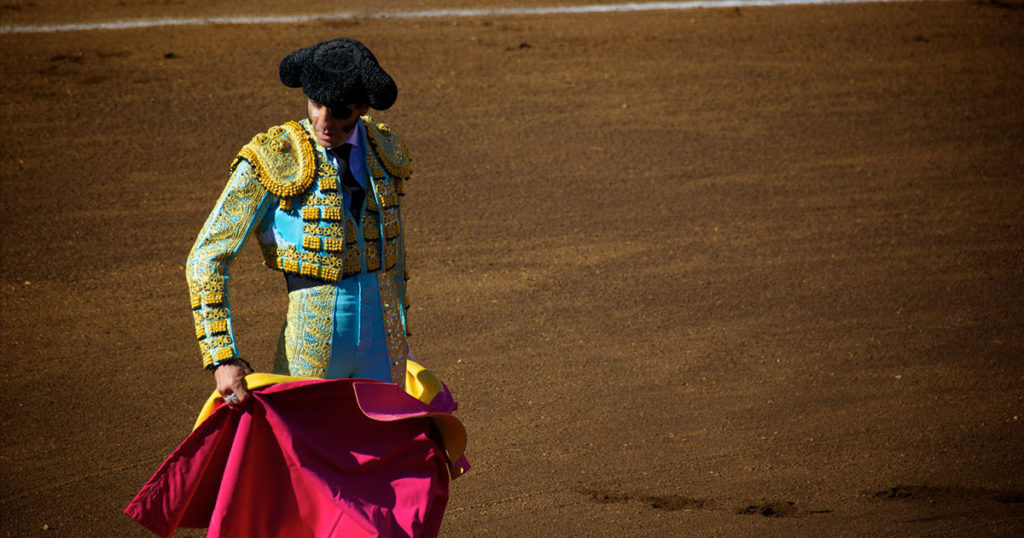
Manolete, the best bullfighter ever, bullfighting adherents claim. Lupe Sino, a woman before her time, sympathizers note. Joaquin Sabina, the greatest living Spanish singer-songwriter, his fans insist. The first two, ill-fated lovers, are celebrated by the third in his song, “De Purísima y Oro.”
The purísima y oro of the song’s title, sky blue and gold, are colors of the bullfighter’s costume, el traje de luces. Other common colors are ivory, olive, tobacco, jet, scarlet, white, purple, and the pink of rosa palo—colors chosen according to the bullfighter’s taste or superstitious beliefs. But more than the ceremonial details of bullfighting, the story of one bullfighter, or doomed love, the song celebrates the routine sufferings of the Spanish people in the decade following the civil war. From headquarters in Burgos, on April 1st, 1939, Franco announced the end of the war. “En el día de hoy,” he proclaimed: “On this day, the Red Army captive and disarmed, the Nationalist troops have achieved their final military objectives. The war is over.”
But the hardships continued. In a documentary on the años posguerra, the postwar years, one person after another says the posguerra was worse than the war. People were hungry, they were cold. Materials were shoddy, food scarce. Medicine was difficult to come by. Tuberculosis afflicted many, and often the only tonic was chicken broth. The orphanages were full. Life was hard. For years, executions of Republican soldiers and sympathizers were daily occurrences. Many of these people fled to France but were captured on their return at the outbreak of World War II. But in 1947, the posguerra period ended, it is said, when on an August afternoon in the bullring at Linares, in Jaén, Manolete faced the bull Islero.
The fight was to be the bullfighter’s last before retiring. To the country’s sorrow it was his last; Manolete’s death followed the goring that afternoon as he went in for the kill, the horn tearing open the femoral artery in his thigh.
In the infirmary at the bullring, the hemorrhaging was stopped, and after infusions for the terrible spilling of blood, Manolete, now out of immediate danger, was carried on a stretcher through the streets to the town’s hospital. The wound from a goring, however, is a dirty wound, and to bolster the patient, doctors administered what they had on hand—plasma from World War II supplies, several years old and, as it turned out, tainted. Manolete went into shock and before morning had died. It was August 29, 1947. Lupe, kept waiting outside the hospital room, was finally admitted when Manolete had already breathed his last.
It was the end of Manolete, the end of a love affair, and though the country remained under martial law until the following April, the end of the terrible posguerra period. Living was easier, and so was staying alive. Life as it had been lived became the stories told—chilblains, castor oil, cheap canvas shoes, long lines and empty shop shelves, wood gas generators, fur stoles with claws still attached, up-market prostitutes in Pedro Chicote’s bar, Eva Perón’s hairstyle and her tour, the glamour of foreign actresses and local celebrities, Spanish artists quietly sailing to other shores, and in the background the daily rat-a-tat of firing squads—stories painted not in the ash and black Picasso used to render the wartime atrocity of Guernica, but painted in words, shaded by the gravely voice of the singer. In this story of those hard, gray years, the brightest splash of color, purísima y oro, is inspirational: Manolete did not wear those colors on the day he died but the less resounding rosa palo. As Sabina charmingly explains, you can’t in the same way celebrate death in pink as death in the saintly colors of sky blue and gold. Words of the greatest living Spanish singer-songwriter, some say. Many say.

